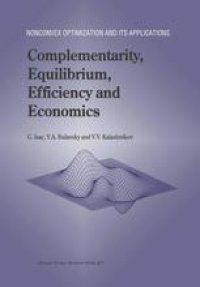
Ebook: Complementarity, Equilibrium, Efficiency and Economics
- Tags: Mathematical Modeling and Industrial Mathematics, Economics general, Optimization, Computational Mathematics and Numerical Analysis, Game Theory Economics Social and Behav. Sciences
- Series: Nonconvex Optimization and Its Applications 63
- Year: 2002
- Publisher: Springer US
- Edition: 1
- Language: English
- pdf
In complementarity theory, which is a relatively new domain of applied mathematics, several kinds of mathematical models and problems related to the study of equilibrium are considered from the point of view of physics as well as economics. In this book the authors have combined complementarity theory, equilibrium of economical systems, and efficiency in Pareto's sense. The authors discuss the use of complementarity theory in the study of equilibrium of economic systems and present results they have obtained. In addition the authors present several new results in complementarity theory and several numerical methods for solving complementarity problems associated with the study of economic equilibrium. The most important notions of Pareto efficiency are also presented.
Audience: Researchers and graduate students interested in complementarity theory, in economics, in optimization, and in applied mathematics.
In complementarity theory, which is a relatively new domain of applied mathematics, several kinds of mathematical models and problems related to the study of equilibrium are considered from the point of view of physics as well as economics. In this book the authors have combined complementarity theory, equilibrium of economical systems, and efficiency in Pareto's sense. The authors discuss the use of complementarity theory in the study of equilibrium of economic systems and present results they have obtained. In addition the authors present several new results in complementarity theory and several numerical methods for solving complementarity problems associated with the study of economic equilibrium. The most important notions of Pareto efficiency are also presented.
Audience: Researchers and graduate students interested in complementarity theory, in economics, in optimization, and in applied mathematics.
In complementarity theory, which is a relatively new domain of applied mathematics, several kinds of mathematical models and problems related to the study of equilibrium are considered from the point of view of physics as well as economics. In this book the authors have combined complementarity theory, equilibrium of economical systems, and efficiency in Pareto's sense. The authors discuss the use of complementarity theory in the study of equilibrium of economic systems and present results they have obtained. In addition the authors present several new results in complementarity theory and several numerical methods for solving complementarity problems associated with the study of economic equilibrium. The most important notions of Pareto efficiency are also presented.
Audience: Researchers and graduate students interested in complementarity theory, in economics, in optimization, and in applied mathematics.
Content:
Front Matter....Pages i-xvii
Front Matter....Pages 1-1
Introduction....Pages 3-18
Optimization Models....Pages 19-41
General Economic Equilibrium....Pages 43-58
Models of Oligopoly....Pages 59-94
Oligopoly with Leaders....Pages 95-110
Front Matter....Pages 111-111
Complementarity Problems with Respect to General Cones....Pages 113-148
Pseudomonotone and Implicit Complementarity Problems....Pages 149-195
Front Matter....Pages 196-196
Complementarity Pivot Methods....Pages 197-229
Scarf Type Algorithms....Pages 231-249
Newton-Like Methods....Pages 251-272
Parametrization and Reduction to Nonlinear Equations....Pages 273-297
Front Matter....Pages 298-298
Efficiency....Pages 299-386
Approximative Efficiency....Pages 387-434
Back Matter....Pages 435-449
In complementarity theory, which is a relatively new domain of applied mathematics, several kinds of mathematical models and problems related to the study of equilibrium are considered from the point of view of physics as well as economics. In this book the authors have combined complementarity theory, equilibrium of economical systems, and efficiency in Pareto's sense. The authors discuss the use of complementarity theory in the study of equilibrium of economic systems and present results they have obtained. In addition the authors present several new results in complementarity theory and several numerical methods for solving complementarity problems associated with the study of economic equilibrium. The most important notions of Pareto efficiency are also presented.
Audience: Researchers and graduate students interested in complementarity theory, in economics, in optimization, and in applied mathematics.
Content:
Front Matter....Pages i-xvii
Front Matter....Pages 1-1
Introduction....Pages 3-18
Optimization Models....Pages 19-41
General Economic Equilibrium....Pages 43-58
Models of Oligopoly....Pages 59-94
Oligopoly with Leaders....Pages 95-110
Front Matter....Pages 111-111
Complementarity Problems with Respect to General Cones....Pages 113-148
Pseudomonotone and Implicit Complementarity Problems....Pages 149-195
Front Matter....Pages 196-196
Complementarity Pivot Methods....Pages 197-229
Scarf Type Algorithms....Pages 231-249
Newton-Like Methods....Pages 251-272
Parametrization and Reduction to Nonlinear Equations....Pages 273-297
Front Matter....Pages 298-298
Efficiency....Pages 299-386
Approximative Efficiency....Pages 387-434
Back Matter....Pages 435-449
....